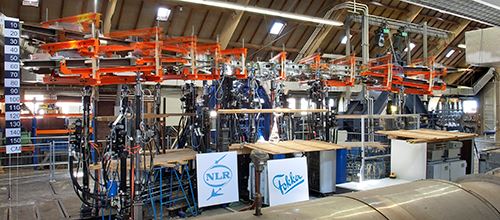TAPAS 2: Next steps in thermoplastic aerostructures
The Netherland's-based Thermoplastic Affordable Primary Aircraft Structure (TAPAS) consortium's TAPAS 2 team builds on the successes of TAPAS 1, taking the next steps in aircraft thermoplastic composites architecture.
Share
The Thermoplastic Affordable Primary Aircraft Structure (TAPAS) consortium was launched in The Netherlands in 2009 with the goal of developing new thermoplastic composite materials and processes for use in Airbus (Toulouse, France) aerostructures. The consortium is starting its second phase of application and material development, and its members hope, by 2017, to bring to market a thermoplastic composite fuselage and torsion-box concept that proves the viability of thermoplastics in commercial aerostructures.
In addition to Airbus, the TAPAS consortium comprises a number of composite material suppliers, composite parts manufacturers and academic research institutions based in The Netherlands. They include project lead Fokker Aerostructures (Hoogeveen), the Airborne Technology Center and Kok & Van Engelen (both based in The Hague), Dutch Thermoplastic Components (Alkmaar), Technobis Fibre Technologies (Uitgeest), TenCate Advanced Composites (Nijverdal), KE-works, CoDeT and Technische Universiteit Delft (all based in Delft), the University of Twente (Enschede) and the National Aerospace Laboratory, in Amsterdam.
Arnt Offringa, director R&D at Fokker, says that under the first phase of the program, called TAPAS 1, the consortium was asked by Airbus to investigate the use of thermoplastic composites (TPCs) in an aircraft fuselage structure. Fokker added torsion boxes (typically tails and/or wings) as another application area. Material used was a new TenCate unidirectional carbon fiber prepreg with Hexcel (Stamford, Conn.) AS4 fibers and Arkema (Colombes, France) polyetherketoneketone (PEKK) matrix. Processes used were automated fiber placement, press forming and welding.
Offringa says the result, unveiled in 2013, was a demonstrator fuselage panel of technology readiness level (TRL) 3 and a 12m/39-ft torsion box for a tail structure of TRL 5. (Maximum TRL is 9, which means the part or structure is fully tested and operational.) Test results for the structure, he says, were encouraging. The TPC parts showed 10 percent weight savings compared to thermoset materials, primarily because the thermoplastic’s inherent toughness better prevents crack propagation and, therefore, allows the use of thinner laminates. Further, the stiffener and skin designs were segregated, which increased design freedom and promoted weight optimization.
Consortium signatories forged the contract for TAPAS 2 on Jan. 20, this year. Currently in launch mode, the TAPAS 2 consortium is taking both of the TAPAS 1 structures further up the TRL scale. Offringa says “the technology is very promising and worthwhile” and is confident that thermoplastics will continue to prove feasible in commercial aerospace.
For the torsion box, he says, the goals include generating allowables, qualifying materials and processes, developing a “wet” box that can contain fuel and using a part architecture that features beams welded to skin. Offringa says TAPAS 2 hopes to have the technology for a dry box at TRL 6 by the end of 2015, and several airframers have expressed interest in real-world applications of the technology.
The fuselage panel, it’s hoped, will be matured to TRL 4 by 2017. The fuselage panel challenge, says Offringa, is managing skin thickness, particularly for single-aisle craft the size of an Airbus A320 or a Boeing 737. “These laminates are relatively thin,” he notes. “Design based on loading is thin, but local loads — for hail strike or maintenance tool impact — can cause a thickness increase. For these thin structures, a tough material will fare better. But the real question is, ‘How thin a skin can we get that will comply with all requirements?’”
In the long term, the hope is that TPCs can be proven a viable option for the successor to a narrow-body program. Offringa says that in addition to TPC, Airbus is considering and looking closely at aluminum and thermoset prepregs.
About 60 percent of TAPAS 2’s €24 million budget will come from consortium partners, with the Dutch government providing the balance in the form of “risk-free” loans (e.g., the Netherlands Ministry of Economic Affairs is supporting the ongoing partnership with a loan of €9.5 million). When revenue is derived from the project, the loans will be repaid to the Dutch government.
Related Content
TU Munich develops cuboidal conformable tanks using carbon fiber composites for increased hydrogen storage
Flat tank enabling standard platform for BEV and FCEV uses thermoplastic and thermoset composites, overwrapped skeleton design in pursuit of 25% more H2 storage.
Read MoreWelding is not bonding
Discussion of the issues in our understanding of thermoplastic composite welded structures and certification of the latest materials and welding technologies for future airframes.
Read MoreOptimizing a thermoplastic composite helicopter door hinge
9T Labs used Additive Fusion Technology to iterate CFRTP designs, fully exploit continuous fiber printing and outperform stainless steel and black metal designs in failure load and weight.
Read MoreCombining multifunctional thermoplastic composites, additive manufacturing for next-gen airframe structures
The DOMMINIO project combines AFP with 3D printed gyroid cores, embedded SHM sensors and smart materials for induction-driven disassembly of parts at end of life.
Read MoreRead Next
Plant tour: Daher Shap’in TechCenter and composites production plant, Saint-Aignan-de-Grandlieu, France
Co-located R&D and production advance OOA thermosets, thermoplastics, welding, recycling and digital technologies for faster processing and certification of lighter, more sustainable composites.
Read MoreDeveloping bonded composite repair for ships, offshore units
Bureau Veritas and industry partners issue guidelines and pave the way for certification via StrengthBond Offshore project.
Read MoreAll-recycled, needle-punched nonwoven CFRP slashes carbon footprint of Formula 2 seat
Dallara and Tenowo collaborate to produce a race-ready Formula 2 seat using recycled carbon fiber, reducing CO2 emissions by 97.5% compared to virgin materials.
Read More



























